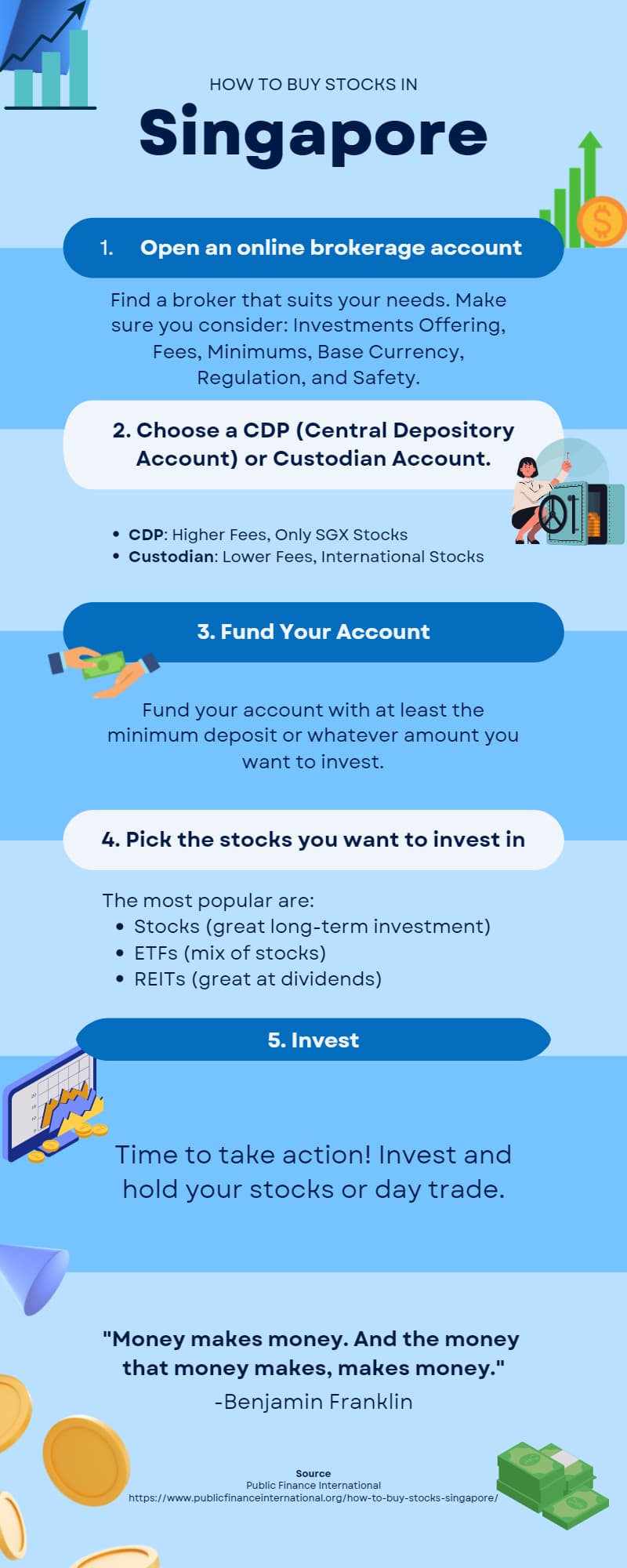The stock market in Singapore favors passive investors who wish to chill out while collecting monthly dividends. It isn’t rocket science, you don’t need to be an expert to invest in rewarding shares in Singapore. You only need to follow the 5 easy steps we’re going to share with you in this guide, and you should be ready to start investing!
Why it’s a Good Idea to Start Investing in Stocks in Singapore
Before we jump into showing you how to be a successful investor in Singapore, you should first know why you should even purchase stocks in Singapore.
Stocks are an excellent addition to any financial portfolio. Investing in stocks can help you develop your savings, maximize your investment income, and safeguard your money from taxes and inflation. you can buy shares of companies listed on every stock exchange as a retail investor. It has the potential to generate substantial profits, whether in terms of dividends or capital gains. So overall, investing in shares of companies you trust in is one approach to profit from their future growth.
You can purchase Exchange Traded Funds (ETFs) in the same way that stocks are, which are funds that track a specific index and usually low-cost.

How to Buy Stocks in Singapore: 5 Easy Steps
As we mentioned earlier, investing in stocks is easier than many people think. In fact, it could be done in only 5 easy steps that are fully digital and take minutes to complete.
Step 1: Create a Central Depository Account (CDP)
A Central Depository Account (CDP) account is required since it keeps and safeguards your Singapore securities, including stocks and other securities listed on the Singapore Exchange. Dividends will be credited to your CDP only if you link your bank account to it.
If you want, you can skip this step and avoid the account opening, but only if you’re going to make a plan to save money regularly. One option to acquire shares without the need for a broker in Singapore is to set up a Regular Savings Plan (RSP). These are easy to set up via a provider that offers them, like OCBC, DBS, POEMS, FSMOne, and UOB.
Alternatively, you can use a broker account with a custodian instead of a CDP-linked broker account. The CDP account is only for Singapore equities, meaning that owning one won't help you buy stocks from other countries. the broker you’re dealing with in this case will serve as the custodian for any international stock purchases you make.
If you’re still in doubt about the CDP account, creating one and testing the waters is a good idea. It shouldn’t take a lot of your time since it no longer requires you to walk down to the CDP branch to create it.
Step 2: Create an Account with an Online Broker
Online brokers are a great way to make your trades, but not all online brokers are created equal, so you must do your research before deciding which one you’ll trade with. You need to consider things like your preferred trading currency, trading fees, and minimum funding.
Once you’ve decided which online broker is the right one, it’s time to sign up for it. The signup process in most respected online brokers is hassle-free, so you shouldn’t have many issues getting your account verified and starting to trade. You can benefit from SingPass in the signup process, which reduces the manual information inputs required and speeds up the process.
We recommend investing with Interactive Brokers, Phillip Securities or SAXO Markets if you're a beginner. If you buy equities on the Singapore Exchange, these two offer very attractive fees and no minimum commission.
Step 3: Start Funding Your Account
Just like you need to top up your e-wallet before making a purchase, you must fund it first before you can buy any stocks in case you're using a pre-funded account. Funding your account can be a prerequisite to getting rewards and bonuses from the Investment platform in Singapore.
Before funding your online trading account, you should first consider the number of shares you plan to acquire as well as their cost.It’s a good idea to have slightly more money in your account than you think you'll need, don’t forget about the fees!
Step 4: Pick the Stock You Wish to Invest in
After successfully funding your online trading account, you’ll find yourself in front of many stock options to pick from, to help you narrowing your scope a little bit, you may want to consider one of these three:
- Blue Chip Stocks like Singtel, Keppel, and DBS, which are highly stable and perfect for a long-term investment. These may not grow as quickly as some foreign companies like Tesla for example, but they are typically considered extremely stable. A lot of investors hold these stocks for a long time and ultimately get the benefits of dividends.
- Real Estate Investment Trusts (REIT), which makes you a part-landlord with the minimum possible hassle and pays out high dividends.
- Exchange Traded Funds (ETFs), which are a collection of the top best performing stocks.
Large corporations such as Apple, Facebook, Coca-Cola, Netflix, and Nike are popular and highly tradable in the market. You also want to check the big companies listed on the SGX, such as CapitaLand, OCBC, Keppel, Singtel, Dairy Farm, and others.
Before you dive in and make risky investing decisions, we recommend that you spend some time reading about investing in stocks. This entails gaining a thorough understanding of each company's history, operations, financials, and future plans.
Step 4: Purchase Your First Share
Now that you’ve created your account, funded it, and decided what stock(s) you want to purchase, it’s time to take action. One of the most crucial things to consider when buying stocks via an online broker is the price at which you are purchasing the stock. Another thing you want to look out for is the number or stock units/lots you’re purchasing and whether there’s a set number of lots that must be purchased. In most cases, the minimum number of shares to purchase for Singapore stocks is 100, meaning that if you buy 100 lots of DBS shares at S$20 apiece, you'll spend S$2,000 (excluding fees).
The final price you'll pay to purchase the stocks will be determined by these two variables, as well as the fees imposed.
You can also save time and money by first investing in index-tracking ETFs. The following is a list of our recommended ETFs for Singapore-based investors:
| ETF Name | Expense Ratio | Stock Code in SGX | What it tracks | Recommended For |
| STI ETF | 0.3 | ES3 | STI (Singapore’s best 30 companies) | Long-term, low cost investment |
| PRINCIPAL ASEAN40 | 0.83 | QS0 | FTSE/ASEAN 40 Index | Keeping track the performance of best ASEAN companies |
| Nikko AM STI ETF | 0.3 | G3B | STI (Singapore’s best 30 companies) | Long-term capital gains |
| ABF SG BOND ETF | 0.26 | A35 | iBoxx ABF Singapore Bond Index | Avoiding overexposure to shares |
| SDPR S&P500 ETF | 0.09 | S27 | S&P500 | Tracking the best 500 companies in the United States |
| IS ASIA BND | 0.31 | QL2 | J.P. Morgan Asia Credit Index | Passive income via bonds, instead of stocks |
| PHLP AP DIV REIT | 1.14 | BYJ | iEdge APAC ex Japan DividendLeaders REIT Index | Generating income from the real estate sector in Asia (not including Japan) |
| LION-PHILLIP S-REIT | 0.6 | CLR | Morningstar Singapore REIT Yield Focus Index | Capital growth with dividends that are based on the est real estate companies based in Singapore |
Some brokers allow you to reinvest cash dividends automatically, but if you don’t select this option, the dividends will be paid in cash. Then you can decide whether to immediately reinvest your cash using the dollar cost averaging method or just to keep it.
Step 5: Make Sure the Share is in Your Trading Account
After having everything in place, you need to make sure the broker has triggered your order and that you can actually see the share in your trading account. Some platforms send you an email or SMS when your order is successful.
The CDP account is useful since it allows you to see your consolidated securities purchases in one place, regardless of the number of accounts you own. In platforms like Tiger Brokers, you can check if the share is in your wallet under the ‘Trade’ section.
Key Takeaways
As you may have already noticed, it isn’t too complicated to invest in stocks in Singapore. You only need to create an account, fund it, pick the stock, and purchase it. Now that you have a basic understanding of investing in stocks in Singapore, you can now go ahead and take pride in owning parts of the top companies while sitting back and enjoying the passive income you make on a regular basis, or if you don’t mind the risk, you can start trading these stocks in an attempt to make large profits!




